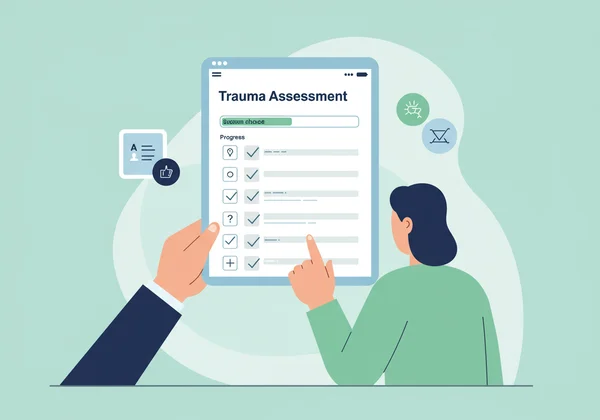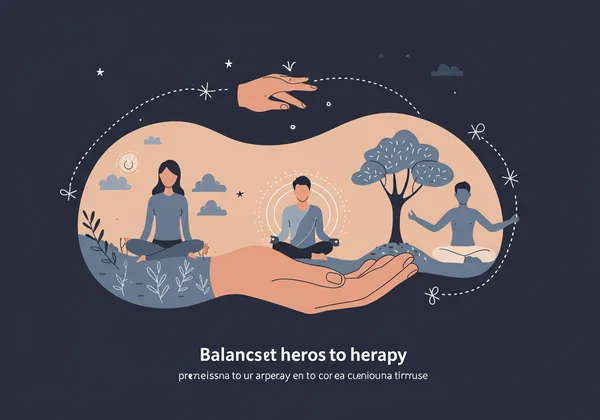Trauma Test & Healing: Your Roadmap to Recovery and Post-Traumatic Growth
Are you feeling stuck, just "coping" with past experiences, or wondering if true healing from trauma is possible? It’s a brave question to ask, and it’s one that many people grapple with in silence. The impact of trauma can feel overwhelming, shaping our perceptions, emotions, and relationships in ways we might not even consciously recognize. But there is a roadmap to move beyond survival, navigate the complex trauma healing journey, and ultimately discover the possibility of profound personal growth.
Understanding where you stand is the crucial first step. If you've been asking yourself, "How do I know if I have trauma?" or "am I traumatized quiz," tools designed for initial self-reflection can provide valuable insights. Taking a free and anonymous online trauma test can offer a preliminary understanding of your experiences. This guide is here to light your way, offering comprehensive trauma recovery steps and an exploration of what it means to truly heal. Ready to begin? You can take a free trauma test to understanding and healing by exploring the resources offered on this platform.

Essential Trauma Recovery Steps: Your Path Forward
The journey of trauma recovery is not linear; it’s a dynamic process with ups and downs. However, there are common, essential stages that help build a strong foundation for lasting well-being. These steps provide a framework for navigating the path forward, offering a sense of direction when feelings may feel chaotic.
Understanding Trauma's Impact: More Than Just Memories
Trauma isn't just a bad memory locked away in your mind. It's a full-body, whole-person experience. Psychological trauma can rewire the brain, affecting emotional regulation, sleep patterns, concentration, and even physical health. It can manifest as anxiety, depression, difficulty in relationships, or a constant sense of unease. Recognizing these broader impacts helps validate your feelings and experiences, moving beyond the idea that you should "just get over it." Your body and mind are simply responding to what they’ve endured, trying to protect you. Understanding this is foundational for the entire healing journey.
Building Safety & Stability: Laying the Foundation for Healing
Before engaging with the traumatic event itself, it's vital to establish a sense of safety and stability. This means creating a secure physical and emotional environment in your present life. It involves identifying and minimizing current threats, whether they are external (unhealthy relationships, unsafe living conditions) or internal (negative self-talk, self-sabotaging behaviors). Developing reliable coping mechanisms and consistent routines can foster a feeling of predictability and control, which is often severely eroded by traumatic experiences. Focus on grounding techniques, setting boundaries, and creating a supportive network.

Processing Traumatic Experiences: Engaging with the Past Safely
Once a foundation of safety is established, the work of processing the traumatic experiences can begin. This is often the most challenging, yet crucial, phase. It involves confronting memories, emotions, and physical sensations associated with the trauma in a controlled and supported environment, typically with a qualified professional. The goal isn't to relives the trauma, but to integrate it into your life narrative in a way that reduces its power over your present. This process helps to desensitize the emotional triggers and make sense of what happened, leading to significant emotional relief and fostering resilience.
Reconnecting with Self & Others: Restoring Trust and Connection
Trauma often isolates individuals, eroding trust in oneself and in others. Reconnecting is a vital trauma recovery step. This involves rebuilding a positive relationship with yourself – recognizing your inherent worth, practicing self-compassion, and rediscovering your strengths. Simultaneously, it means carefully re-engaging with healthy relationships, learning to trust again, and communicating your needs effectively. This phase helps heal the relational wounds of trauma, fostering a sense of belonging and support crucial for long-term wellness.
Discovering Post-Traumatic Growth (PTG): Beyond Survival
While the focus of trauma healing is often on recovering from the pain, an equally powerful aspect is the possibility of post-traumatic growth (PTG). This isn't about ignoring the pain, but recognizing that profound personal development can emerge from struggling with highly challenging circumstances. It's about transcending mere survival and finding new meaning in life.

Identifying the Pillars of Post-Traumatic Growth
Research suggests that post-traumatic growth often manifests in five key areas:
- Greater appreciation for life: A renewed sense of gratitude and valuing everyday moments.
- Deeper relationships: Enhanced compassion and intimacy with others.
- New possibilities: Identifying new paths or purposes previously unimagined.
- Increased personal strength: A profound realization of one's own fortitude and inner strength.
- Spiritual change: A deeper understanding of life's meaning, purpose, or a stronger spiritual connection. Recognizing these pillars can help you identify areas where growth may already be occurring in your own life.
Cultivating Resilience and Inner Strength
Trauma, paradoxically, can be a crucible for cultivating incredible resilience and inner strength. Facing and navigating immense pain can reveal capacities you never knew you possessed. This isn't to say trauma is desirable, but that humans have an extraordinary ability to adapt and grow even after the most devastating experiences. Actively engaging in healing reinforces this strength, allowing you to face future challenges with greater confidence and self-efficacy.
Finding New Meaning and Purpose After Trauma
One of the most transformative aspects of the trauma healing journey is finding new meaning and purpose. This could involve advocating for others, pursuing a long-held dream, or simply living with a deeper sense of authenticity. It’s about integrating the traumatic experience not as something that defines you, but as a part of your story that has, against all odds, contributed to a richer, more compassionate, and purposeful existence. This doesn't erase the past, but it reshapes its significance.
Navigating Your Unique Healing Journey with Support
Your trauma healing journey is profoundly personal and unique. There's no one-size-fits-all solution, but there are common themes and vital support systems that can make a world of difference. Embracing a holistic approach, which includes both professional guidance and self-care, is essential for long-term wellness.

The Crucial Role of Professional Support
While self-help resources are valuable, for many, professional support is indispensable for trauma recovery. Therapists specializing in trauma (e.g., those trained in EMDR, CBT, Somatic Experiencing) can provide a safe space and expert guidance to process experiences, develop coping skills, and heal underlying wounds. They can help you understand your trauma response test results or an ACEs test better. It's important to remember that seeking professional help is a sign of strength, not weakness, and it provides a structured path for healing that can be difficult to navigate alone.
Self-Care and Healthy Coping Mechanisms for Long-Term Wellness
Beyond therapy, integrating self-care and healthy coping mechanisms into your daily life is vital. This includes practices like mindfulness, meditation, regular exercise, balanced nutrition, sufficient sleep, and creative expression. These activities help regulate the nervous system, reduce stress, and promote emotional well-being. They empower you to manage daily stressors and build a robust foundation for long-term emotional health, complementing any professional treatment you receive.
Embracing Patience, Compassion, and Hope
The trauma healing journey is a marathon, not a sprint. It requires immense patience, self-compassion, and an unwavering commitment to hope. There will be good days and challenging days. It’s crucial to treat yourself with the kindness you would offer a dear friend, acknowledging your progress no matter how small. Holding onto hope, the belief that things can and will get better, is a powerful motivator to continue moving forward.
Your Healing Journey Begins Now: Taking the First Step
Embarking on a trauma healing journey is one of the bravest steps you can take. It’s a commitment to yourself, to understanding your experiences, and to building a life filled with peace, connection, and purpose. Remember, healing is possible, and many have walked this path before you, emerging with incredible post-traumatic growth.
If you're ready to take that crucial first step towards understanding your experiences, a powerful starting point is to gain some initial insights into your symptoms. A free and anonymous online test is available here, designed for both kids and adults. This initial screening can help you understand your potential trauma symptoms, providing a foundation for further exploration. It's a straightforward, confidential way to begin your journey of understanding and empowerment.
Ready for clarity? Visit TraumaTest.org to take your free trauma test and unlock your personalized insights. Explore our other blog resources for more information on PTSD test, childhood trauma test, and pathways to healing. Your path to recovery and growth is waiting.
Frequently Asked Questions About Trauma Healing & Recovery
How do I start healing from childhood trauma?
Starting the healing journey from childhood trauma test often begins with acknowledging its impact. A valuable first step is to gain an initial understanding of your symptoms, which can be done confidentially through an online trauma test like the one offered on this platform. This can help you recognize patterns and prepare to seek professional guidance, which is often crucial for processing complex past experiences.
Can you truly heal from past trauma?
Yes, true healing from past trauma is absolutely possible, although it's often a process of integration rather than eradication. While memories may remain, their emotional charge can lessen significantly, allowing you to live a fulfilling life. This often involves professional support, building healthy coping skills, and cultivating post-traumatic growth. Many find profound transformation on their trauma healing journey.
What are the stages of trauma recovery?
The trauma recovery steps often include: establishing safety and stabilization, processing and remembering the traumatic events (often with professional guidance), and reconnecting with oneself and others while finding meaning. These stages aren't always linear, and individuals may move back and forth, but they provide a helpful framework for understanding the healing process. Getting a preliminary understanding of your symptoms through a free trauma test can be a part of the initial stabilization phase.
What is Post-Traumatic Growth?
Post-Traumatic Growth (PTG) refers to the positive psychological changes that can occur as a result of struggling with highly challenging, traumatic life circumstances. It involves finding new meaning, developing greater personal strength, improving relationships, and having a deeper appreciation for life. It's a testament to human resilience and the capacity for growth even in the face of adversity.